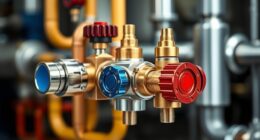Are you exhausted from being burdened by exorbitant energy expenses? We have the perfect solution for you!
In this article, we’ll show you how to evaluate heat pump energy efficiency in HVACs. By understanding common metrics like SEER ratings and COP values, you’ll be able to make informed decisions when choosing a heat pump.
We’ll also delve into the importance of Energy Star certification in maximizing HVAC efficiency.
Get ready to liberate yourself from wasteful energy consumption!

Key Takeaways
- SEER and HSPF ratings are important metrics for evaluating heat pump energy efficiency in HVAC systems.
- Higher SEER and HSPF ratings indicate greater energy efficiency and potential savings.
- Comparing COP values of different heat pump models helps make informed decisions about energy efficiency.
- Analyzing the Seasonal Performance Factor (SPF) helps evaluate the overall energy efficiency of heat pump systems.
Common Metrics for Evaluating Heat Pump Energy Efficiency
Let’s explore the common metrics used to evaluate the energy efficiency of heat pumps in HVAC systems.
When it comes to assessing heat pump performance, one key metric is the Seasonal Energy Efficiency Ratio (SEER). SEER measures the cooling output of a heat pump over a typical cooling season, divided by the energy input in watt-hours. A higher SEER rating indicates greater energy efficiency.
Another important metric is the Heating Seasonal Performance Factor (HSPF), which measures the heating output of a heat pump over a typical heating season, divided by the energy input in watt-hours. Similar to SEER, a higher HSPF rating signifies improved energy efficiency.
Understanding these metrics allows us to accurately assess the energy efficiency of heat pumps in HVAC systems.

Now, let’s delve into the next section and understand SEER ratings in HVAC systems.
Understanding SEER Ratings in HVAC Systems
We will now explore the concept of SEER ratings in HVAC systems to gain a better understanding of their significance in evaluating energy efficiency. SEER stands for Seasonal Energy Efficiency Ratio, and it’s a metric used to measure the cooling efficiency of an HVAC system over a typical cooling season. Understanding SEER ratings is crucial in making informed decisions about energy-efficient HVAC systems.
Here are some key points to consider:
- SEER ratings help consumers compare the efficiency of different HVAC systems.
- Higher SEER ratings indicate greater energy efficiency and potential energy savings.
- Heat pump technology advancements and the benefits of variable speed compressors contribute to higher SEER ratings.
Comparing COP Values of Different Heat Pump Models
When comparing different heat pump models, we can consider the COP values to determine their energy efficiency. COP, or Coefficient of Performance, is a measure of how effectively a heat pump can convert electricity into heating or cooling output. Higher COP values indicate greater energy efficiency. The advancements in heat pump technology have resulted in improved COP values over the years, making heat pumps a more sustainable and cost-effective heating and cooling solution. However, it is important to note that several factors can affect the COP values of heat pumps. These factors include ambient temperature, humidity, system design, refrigerant type, and maintenance. By comparing the COP values of different heat pump models, consumers can make informed decisions about which model is best suited for their specific needs and achieve optimal energy efficiency.

| Heat Pump Model | COP Value |
|---|---|
| Model A | 3.5 |
| Model B | 4.2 |
| Model C | 3.9 |
| Model D | 4.5 |
Analyzing Seasonal Performance Factor (SPF) in Heat Pumps
To accurately assess the energy efficiency of heat pumps, we must analyze the Seasonal Performance Factor (SPF), which takes into account the variations in performance across different seasons. The SPF is a measure of the ratio between heat output and energy consumption over an entire heating season. By analyzing the SPF, we can evaluate the overall energy efficiency of a heat pump system and determine if it meets the desired standards.
When analyzing energy consumption, it’s crucial to consider the specific heat transfer efficiency of the heat pump. This factor measures the effectiveness of the heat pump in transferring heat from the outside air or ground to the indoor space. Evaluating heat transfer efficiency helps identify areas where improvements can be made to optimize energy usage and reduce energy costs.
Understanding the SPF and evaluating heat transfer efficiency are essential steps in determining the energy efficiency of heat pumps. By analyzing these factors, we can make informed decisions about the most efficient and cost-effective HVAC systems for our needs.
Transition: Now that we’ve discussed the importance of analyzing energy consumption and evaluating heat transfer efficiency, let’s move on to the next section: the importance of Energy Star certification in HVAC efficiency.

Importance of Energy Star Certification in HVAC Efficiency
Energy Star certification significantly enhances HVAC efficiency by ensuring that systems meet strict energy performance standards. This certification program, established by the U.S. Environmental Protection Agency (EPA), is designed to promote energy efficiency and reduce greenhouse gas emissions.
When an HVAC system is Energy Star certified, it means that it has undergone rigorous testing and meets or exceeds the energy efficiency guidelines set by the EPA. This certification is important because it allows consumers to easily identify and choose energy efficient HVAC systems, which can lead to significant energy savings and lower utility bills.
Additionally, many energy efficiency incentives and rebates are available for Energy Star certified HVAC systems, further encouraging their adoption. The benefits of energy efficient HVAC systems include reduced energy consumption, improved indoor comfort, and a positive environmental impact.
Frequently Asked Questions
Are There Any Other Factors Besides SEER Ratings That Should Be Considered When Evaluating the Energy Efficiency of HVAC Systems?
When evaluating the energy efficiency of HVAC systems, factors other than SEER ratings should be considered. These factors may include insulation, ductwork, size and layout of the space, and the specific climate conditions.

How Does the COP Value of a Heat Pump Affect Its Overall Energy Efficiency?
The COP value of a heat pump directly affects its overall energy efficiency. It is an important factor to consider when evaluating the performance of HVAC systems. Higher COP values indicate better energy efficiency.
Is SPF a Reliable Metric for Determining the Energy Efficiency of Heat Pumps in All Climates?
SPF is not always reliable to determine heat pump energy efficiency in all climates. Factors such as temperature variations and humidity levels can impact its accuracy. Other metrics like HSPF and SEER should also be considered for a comprehensive evaluation.
Can an HVAC System Be Considered Energy Efficient Even if It Doesn’t Have an Energy Star Certification?
An HVAC system can still be considered energy efficient even without an Energy Star certification. However, to determine its energy efficiency, we need to conduct an energy consumption analysis and compare it to energy efficiency standards.
Are There Any Additional Certifications or Labels That Indicate High Energy Efficiency in HVAC Systems?
There are several certifications, labels, and standards that indicate high energy efficiency in HVAC systems. These certifications evaluate energy consumption, performance metrics, energy savings, and environmental impact. Government regulations, industry guidelines, and consumer awareness also play a role.

Conclusion
Overall, evaluating the energy efficiency of heat pumps in HVAC systems involves considering various metrics such as SEER ratings, COP values, SPF, and Energy Star certification. These measures provide a comprehensive understanding of how efficiently a heat pump operates.
By analyzing these factors, one can make informed decisions about which model to choose for optimal energy savings and reduced environmental impact.
Evaluating heat pump energy efficiency is like peering through a microscope, examining the intricate workings of a complex system to ensure maximum performance.









